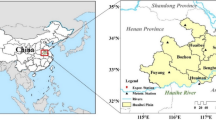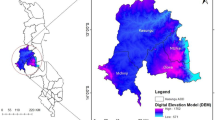Abstract
The African countries are known to be the most vulnerable to climate change and variability and food insecurity. An effort is devoted in this study to assess the year-by-year drought risk to sorghum and millet during the onset of the growing season in the Sudanese Sahel. A recently developed drought risk index (DRI) is used for this purpose. The DRI is a multiplicative formula of six variables, namely frequency, duration, severity and spatial extent of drought, production level and coping capacity through irrigation. A significant finding is that drought at the early stage of the growing season can pose a dramatic risk to crop yield. Analysis and results for 12 provincial states of the region reveal a strong relationship between the probabilistic DRI and yield of these major crops. This relationship offers vital information of a considerable potential risk to crop yield if the drought occurs as early as June and July. Significant proportion of the variations in the crop yield can be explained by the DRI. June DRI expresses up to 68 and 90 % of the variations in sorghum and millet yields, respectively. Up to 84 and 68 % of the respective yields can be explained by June–July DRI. Based on the regional analysis, the median area under drought risk for the entire data period (1970–2006) is 43 % for sorghum and 40 % for millet. From the frequency analysis, the occurrence probabilities of these medians are 41 and 34 %, respectively. Evidence is presented that the agricultural drought risk in this part of the African Sahel is still high during the period 1991 onwards when annual rainfall is said to have been recovering. The present results provide useful information for drought forecasters and decision making in crop and disaster planning and management, especially in view of projected drier and warmer climate conditions during this part of the growing season. Also, the DRI proves to be robust spatially and temporally for agricultural monitoring under situations of limited meteorological data and could be tested for other regions in the African Sahel.










Similar content being viewed by others
References
Adams RM, Hurd BH, Lenhart S, Leary N (1998) Effects of global climate change on agriculture: an interpretative review. Clim Res 11:19–30
Araya A, Stroosnijder L (2011) Assessing drought risk and irrigation need in northern Ethiopia. Agric For Meteorol 151(4):425–436
Ayoub AT (1999) Land degradation, rainfall variability and food production in the Sahelian zone of the Sudan. Land Degrad Dev 10:489–500
Bakhit AR (1994) Availability, affordability and accessibility of food in Khartoum. GeoJournal 34(3):253–255
Balogun OL (2011) Sustainable agriculture and food crisis in sub-Sahara Africa, Chap 20. In: Behnassi M, Draggan S, Yaya S (eds) Global food insecurity: Rethinking agricultural and rural development paradigm and policy. Springer, Dordrecht, pp 283–297
Baltensperger DD (2002) Progress with proso, pearl and other millets. In: Janick J, Whipkey A (eds) Trends in new crops and new uses. ASHS Press, Alexandria, pp 100–103
Blum A, Sulivan CY (1985) The comparative drought resistance of landraces of sorghum and millet from dry and humid regions. Ann Bot 57(6):835–846
Boken VK (2009) Improving a drought early warning model for an arid region using a soil-moisture index. Appl Geogr 29(3):402–408
Central Bureau of Statistics (CBS) (2008) Statistical year book for the year 2007. Ministry of Cabinet, The Republic of Sudan
Chen S, Ravallion M (2007) Absolute poverty measures for the developing world, 1981–2004. Proc Natl Acad Sci USA (PNAS) 104(43):16757–16762
Chen H, Guo J, Zhang Z, Xu CY (2013) Prediction of temperature and precipitation in Sudan and South Sudan by using LARS-WG in future. Theor Appl Climatol 113(3–4):363–375
Collier P (2007) Poverty reduction in Africa. Proc Natl Acad Sci USA (PNAS) 104(43):16763–16768
Elagib NA (2009) Assessment of drought across central Sudan using UNEP dryness ratio. Hydrol Res 40(5):481–494
Elagib NA (2013) Meteorological drought and crop yield in sub-Saharan Sudan I. J Water Resour Arid Environ 3(3):164–171. http://www.psipw.org/attachments/article/341/IJWRAE2%283%29164-171.pdf
Elagib NA (2014) Development and application of a drought risk index for food crop yield in Eastern Sahel. Ecol Indic 43:114–125
Elagib NA, Elhag MM (2011) Major climate indicators of ongoing drought in Sudan. J Hydrol 409(3–4):612–625
Elagib NA, Mansell MG (2000) Climate impacts of environmental degradation in Sudan. GeoJournal 50(4):311–327
Elagib NA, Alvi SH, Mansell MG (1999) Day-length and extraterrestrial radiation for Sudan: a comparative study. Int J Sol Energy 20(2):93–109
Gregory PJ (1982) Interaction of shoot and root characteristics in the response of millet to drought. Drought resistance in crops with emphasis on rice. The International Rice Research Institute (IRRI), Manila, pp 135–143
Hagos SM, Cook KH (2008) Ocean warming and late-twentieth-century Sahel drought and recovery. J Clim 21:3797–3814
Haile M (2005) Weather patterns, food security and humanitarian response in sub-Saharan Africa. Philos Trans R Soc B Biol Sci 360:2169–2182
Hargreaves GH, Samani ZA (1985) Reference crop evapotranspiration from temperature. Appl Eng Agric 1(2):96–99
Hargreaves GL, Hargreaves GH, Riley JP (1985) Agricultural benefits for Senegal River basin. J Irrig Drain ASCE 111:113–124
Henricksen BL, Durkin JW (1986) Growing period and drought early warning in Africa using satellite data. Int J Remote Sens 7(11):1583–1608
Herrmann SM, Anyamba A, Tucker CJ (2005) Recent trends in vegetation dynamics in the African Sahel and their relationship to climate. Glob Environ Change 15:394–404
Hope KR Sr (2009) Climate change and poverty in Africa. Int J Sustain Dev World Ecol 16(6):451–461
Howorth C, O’Keefe P (1999) Drought-induced resettlement: a case study from Burkina Faso. Reg Environ Change 1(1):15–23
Hutchinson CF (1991) Uses of satellite data for famine early warning in sub-Saharan Africa. Int J Remote Sens 12(6):1405–1421
Ibrahim F (1988) Causes of the famine among the rural population of the Sahelian zone of the Sudan. GeoJournal 17(1):133–141
Ibrahim FN (1994) Hunger-vulnerable groups within the metropolitan food system of Khartoum. GeoJournal 34(3):257–261
Lebel T, Ali A (2009) Recent trends in the central and western Sahel rainfall regime (1990–2007). J Hydrol 375:52–64
Lenton TM (2013) What early warning systems are there for environmental shocks? Environ Sci Policy 27:S60–S75
Li Y, Ye W, Wang M, Yan X (2009) Climate change and drought: a risk assessment of crop-yield impacts. Clim Res 39:31–46
Marteau R, Sultan B, Moron V, Alhassane A, Baron C, Traoré SB (2011) The onset of the rainy season and farmers’ sowing strategy for pearl millet cultivation in Southwest Niger. Agric For Meteorol 151(10):1356–1369
Matus J (2007) The future of food security in the Three Areas of Sudan. Disasters 31(s1):s91–s103
Maxwell S, Swift J, Buchanan-Smith M (1990) Is food security targeting possible in sub-Saharan Africa? Evidence from North Sudan. IDS Bull 21(3):52–61
Ministry of Agriculture and Forestry (MAF) (2006) Time series of cropped areas and yield according to the States and irrigation methods (1970/71–004/05). General Administration of Planning and Agricultural Econonomics. Department ofAgricultural Statistics
Mkandawire P, Aguda ND (2009) Characteristics and determinants of food insecurity in sub-Saharan Africa. In: Luginaah IN, Yanful EK (eds) Environment and health in Sub-Saharan Africa: managing an emerging crisis. Springer, Netherlands, pp 3–23
Mortimore M (2010) Adapting to drought in the Sahel: lessons for climate change. WIREs Clim Change 1:134–143
Mortimore MJ, Adams WM (2001) Farmer adaptation, change and ‘crisis’ in the Sahel. Glob Environ Change 11(1):49–57
Nicholson SE (2005) On the question of the “recovery” of the rains in the west African Sahel. J Arid Environ 63:615–641
Omer MA, Saxton E, Bassett DL (1988) Optimum sorghum planting dates in western Sudan by simulated water budgets. Agric Water Manag 13(1):33–48
Parry M (1990) Climate change and world agriculture. Earthscan Publication Ltd, London
Parry M, Rosenzweig C, Iglesias A, Fischer GK, Livermore M (1999) Climate change and world food security: a new assessment. Glob Environ Change 9:S51–S67
Pretty J, Toulmin C, Williams S (2011) Sustainable intensification in African agriculture. Int J Agric Sustain 9(1):5–24
Prince SD, De Colston EB, Kravitz LL (1998) Evidence from rain-use efficiencies does not indicate extensive Sahelian desertification. Glob Change Biol 4:359–374
Ramadan E, Xue-zhi F (2004) Urban planning: a tool for urban poverty alleviation in Sudan. Chin Geogr Sci 14(2):110–116
Rosenzweig C, Parry M (1994) Potential impact of climate change on world food supply. Nature 367:133–138
Rötter R, Van de Geijn SC (1999) Climate change effects on plant growth, crop yield and livestock. Clim Change 43:651–681
Sanogo S, Fink AH, Omotosho JB, Ba A, Redl R, Ermert V (2015) Spatio-temporal characteristics of the recent rainfall recovery in West Africa. Int J Climatol. doi:10.1002/joc.4309
Schumacher J, Luedeling E, Gebauer J, Saied A, El-Siddig K, Buerkert A (2009) Spatial expansion and water requirements of urban agriculture in Khartoum, Sudan. J Arid Environ 73:399–406
Shahid S, Behrawan H (2008) Drought risk assessment in the western part of Bangladesh. Nat Hazards 46(3):391–413
Slingo JM, Challinor AJ, Hoskins BJ, Wheeler R (2005) Introduction: food crops in a changing climate. Philos Trans R Soc B Biol Sci 360(1463):1983–1989
Strzepek K, Yohe G, Neumann J, Boehlert B (2010) Characterizing changes in drought risk for the United States from climate change. Environ Res Lett 5(4):044012. doi:10.1088/1748-9326/5/4/044012
Sun L, Mitchell SW, Davidson A (2012) Multiple drought indices for agricultural drought risk assessment on the Canadian prairies. Int J Climatol 32(11):1628–1639
Thornton PK, Bowen WT, Ravelo AC, Wilkens PW, Farmer G, Brock J, Brink JE (1997) Estimating millet production for famine early warning: an application of crop simulation modelling using satellite and ground-based data in Burkina Faso. Agric For Meteorol 83(1):95–112
Trilsbach A, Hulme M (1984) Recent rainfall changes in central Sudan and their physical and human implications. Trans Inst Br Geogr 15:280–298
UN/ISDR (2007) Drought risk reduction framework and practices: Contributing to the implementation of the Hyogo Framework for Action. United Nations secretariat of the International Strategy for Disaster Reduction (UN/ISDR), Geneva, Switzerland, pp 98+vi
UNEP (1992) World atlas of desertification. Edward Arnold, London
Verdin J, Klaver R (2002) Grid-cell-based crop water accounting for the famine early warning system. Hydrol Process 16(8):1617–1630
Verdin J, Funk C, Senay G, Choularton R (2005) Climate science and famine early warning. Philos Trans R Soc B Biol Sci 360(1463):2155–2168
Waha K, Müller C, Bondeau A, Dietrich JP, Kurukulasuriya P, Heinke J, Lotze-Campen H (2013) Adaptation to climate change through the choice of cropping system and sowing date in sub-Saharan Africa. Glob Environ Change 23(1):130–143
Webb P, Braun JV, Teklu T (1991) Drought and famine in Ethiopia and Sudan: an ongoing tragedy. Nat Hazards 4(1):85–86
Wu H, Wilhite DA (2004) An operational agricultural drought risk assessment model for Nebraska, USA. Nat Hazards 33(1):1–21
Zhang J (2004) Risk assessment of drought disaster in the maize-growing region ofSongliao Plain, China. Agric Ecosyst Environ 102:133–153
Zhang Q, Zhang J, Wang C, Cui L, Yan D (2014) Risk early warning of maize drought disaster in Northwestern Liaoning Province, China. Nat Hazards 72(2):701–710
Author information
Authors and Affiliations
Corresponding author
Rights and permissions
About this article
Cite this article
Elagib, N.A. Drought risk during the early growing season in Sahelian Sudan. Nat Hazards 79, 1549–1566 (2015). https://doi.org/10.1007/s11069-015-1913-5
Received:
Accepted:
Published:
Issue Date:
DOI: https://doi.org/10.1007/s11069-015-1913-5




